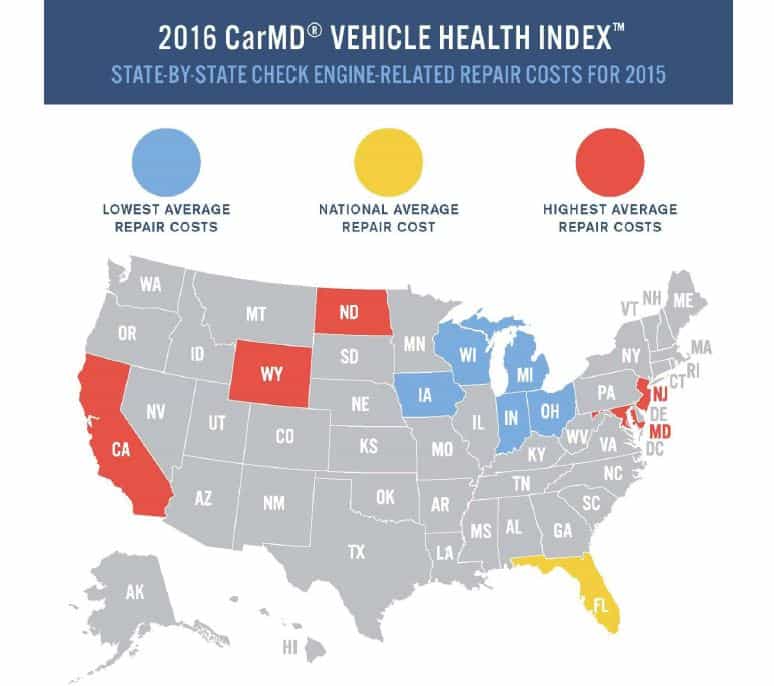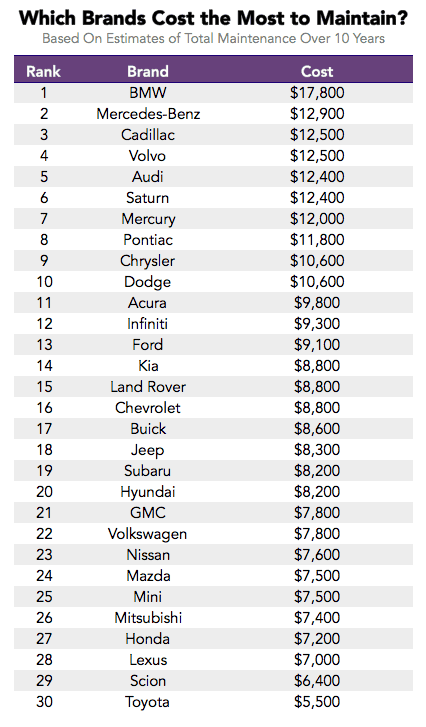 No two mechanics or states are the same for pricing of car repairs some states are more expensive than others. The cost the maintain cars varies by make and model with foreign and luxury model costing the most to maintain. No matter how you put it cars can be expensive to repair and maintain.
No two mechanics or states are the same for pricing of car repairs some states are more expensive than others. The cost the maintain cars varies by make and model with foreign and luxury model costing the most to maintain. No matter how you put it cars can be expensive to repair and maintain.
State Stats
When a vehicle’s check engine light comes on, drivers in California now pay the most ($435) on average, while vehicle owners in Michigan pay the least ($354) to have it fixed, according to CarMD, which analyzed data from more than 1 million vehicles needing repairs in 2015.
The other most expensive repairs are Wyoming (no. 2), Maryland (no. 3), North Dakota (no. 4) and New Jersey (no. 5). After Michigan, the most affordable states for car repairs are Indiana (no. 50), Ohio (no. 49), Wisconsin (no. 48) and Iowa (no. 47).
When vehicles have check engine light problems, the leading culprit is a faulty oxygen sensor, the most frequently diagnosed repair in 25 states. Properly operating oxygen sensors are important to a car’s performance and to the environment; if left unfixed, a faulty O2 sensor can negatively impact a car’s fuel economy and cause damage to other parts of the car.
“The technicians at CarMD can’t stress enough how important it is to address check engine light problems early,” said David Rich, CarMD’s technical director. “Many drivers ignore O2 sensor problems because it seems like their car is driving just fine, but it is really guzzling a lot of extra gasoline and will likely end up causing ancillary problems that drive up car repair costs down the road.”
Rich adds that in addition to addressing check engine issues, it is important for vehicle owners from coast to coast to follow a regularly scheduled service maintenance program to optimize vehicle operating efficiency and reliability.
A leading provider of automotive diagnostic information, CarMD publishes this annual state-by-state ranking as part of its CarMD Vehicle Health Index.
The average cost for check engine light-related repairs in the U.S. in 2015 was $387. 31. Florida is closest to the U.S. average at $387.37, which is just 6 cents from the national mean.
Michigan vehicle owners paid the least for both labor ($150) and parts ($203) on average. Drivers in Wyoming paid the most for labor ($175) on average and vehicle owners in Vermont paid the least for parts ($131). Several factors contribute to average parts and labor costs, including vehicle make and age, parts availability, difficulty of repair and hourly labor rates.
The same repair can vary in cost from state to state. To replace a car’s ignition coil(s) and spark (plugs), the average cost is $435 in Washington, whereas the same type of repair in Vermont costs 16 percent less at $364 on average. A catalytic converter replacement costs on average $1,226 in New Hampshire, but only $891 in Hawaii. And the average cost for parts and labor to replace a car’s oxygen sensor(s) in 2015 varied from a low of $216 in Wyoming to a high of $290 in Delaware.
The least expensive states tend to have a higher percentage of repairs that can be addressed in a matter of minutes versus major parts replacements that require days in the shop. For example, loose gas cap-related problems happened nearly twice as much in Wisconsin as in North Dakota. CarMD encourages vehicle owners to have check engine problems diagnosed early because in many cases it is a common repair like an oxygen sensor or simple, affordable fix like a loose gas cap causing the problem. Addressing warning lights early helps reduce the chances of doing additional damage to your vehicle.
CarMD’s state ranking of repair costs was derived from analysis of 1,019,904 repairs identified for model year 1996 to 2015 vehicles from Jan. 1, 2015 through Dec. 31, 2015 reported to and analyzed by CarMD’s nationwide team of ASE-certified technicians. All 51 U.S. states/districts, including the District of Columbia, are represented in this Index.
The Cost of Maintenance
 Priceonmics crunched numbers to figure out the cost to maintain cars from their data. On average, Americans spend 5% of their income on purchasing a car and another 5% towards on-going vehicle maintenance and insurance costs. In order to figure prices they used oil changes every twice a year. As a car ages it costs more to maintain. The data can not hold true for pure electric cars that don’t require oil changes at all.
Priceonmics crunched numbers to figure out the cost to maintain cars from their data. On average, Americans spend 5% of their income on purchasing a car and another 5% towards on-going vehicle maintenance and insurance costs. In order to figure prices they used oil changes every twice a year. As a car ages it costs more to maintain. The data can not hold true for pure electric cars that don’t require oil changes at all.
Maintenance costs are always increasing. A stable, consistent increase of $150 per year in costs exists for years 1 through 10. After that, there is a distinct jump between 11 and 12 years of age. After age 13, costs plateau around $2,000 per year.
The company warns, “car maintenance is about much more than the average cost. Factors such as how well a car is maintained, how often it is driven, where it is driven, and how hard it is driven all affect maintenance costs. ”
Pricenomics is paid marketing service to generate leads from content.